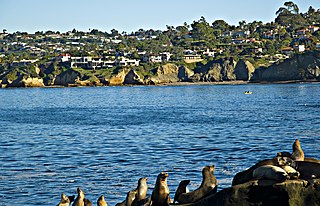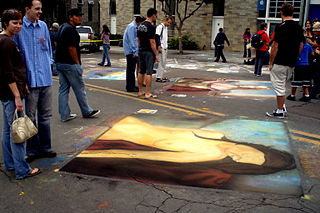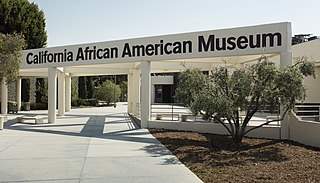Related Research Articles

A film festival is an organized, extended presentation of films in one or more cinemas or screening venues, usually in a single city or region. Increasingly, film festivals show some films outdoors.

San Diego is a city on the Pacific coast of Southern California, adjacent to the Mexico–United States border. With a population of over 1.3 million residents, it is the eighth-most populous city in the United States and the second-most populous in the state of California, after Los Angeles. San Diego is the seat of San Diego County, which has a population of nearly 3.3 million people. It is known for its mild year-round Mediterranean climate, extensive beaches and parks, long association with the United States Navy, and its recent emergence as a healthcare and biotechnology development center.

Hemet is a city in the San Jacinto Valley in Riverside County, California. It covers a total area of 29.3 square miles (76 km2), about half of the valley, which it shares with the neighboring city of San Jacinto. The population was 89,833 at the 2020 census. It borders San Jacinto to the north, East Hemet to the east, Polly Butte and Diamond Valley Lake to the south, and Green Acres and Juniper Springs to the west.

The Castro Theatre is a historic movie palace in the Castro District of San Francisco, California. The venue became San Francisco Historic Landmark #100 in September 1976. Located at 429 Castro Street, it was built in 1922 with a California Churrigueresque façade that pays homage—in its great arched central window surmounted by a scrolling pediment framing a niche—to the basilica of Mission Dolores nearby. Its designer, Timothy L. Pflueger, also designed Oakland's Paramount Theater and other movie theaters in California during that period. The theater has more than 1,400 seats.

San Diego Stadium was a multi-purpose stadium in San Diego, California. Opened in 1967 as San Diego Stadium; it was renamed Jack Murphy Stadium for sportswriter Jack Murphy from 1981 to 1997. From 1997 to 2017, the stadium's naming rights were owned by Qualcomm; it was known as Qualcomm Stadium. The naming rights expired on June 14, 2017, and were purchased by San Diego County Credit Union, renaming the stadium to SDCCU Stadium on September 19, 2017; those naming rights expired in December 2020. Demolition of San Diego Stadium began in December 2020; its last freestanding section was felled on March 22, 2021.

The Gaslamp Quarter is a historic neighborhood in downtown San Diego, California. It extends from Broadway to Harbor Drive and from 4th to 6th Avenue. The neighborhood is listed as a historic district on the National Register of Historic Places as the Gaslamp Quarter Historic District. It includes over 90 historic buildings, most of which were constructed in the Victorian era; many are in use as restaurants, shops, entertainment venues, and nightclubs.

A grindhouse or action house is an American term for a theatre that mainly shows low-budget horror, splatter, and exploitation films for adults. According to historian David Church, this theater type was named after the "grind policy", a film-programming strategy dating back to the early 1920s which continuously showed films at cut-rate ticket prices that typically rose over the course of each day. This exhibition practice was markedly different from the era's more common practice of fewer shows per day and graduated pricing for different seating sections in large urban theatres, which were typically studio-owned.

The culture of San Francisco is major and diverse in terms of arts, music, cuisine, festivals, museums, and architecture but also is influenced heavily by Mexican culture due to its large Hispanic population, and its history as part of Spanish America and Mexico. San Francisco's diversity of cultures along with its eccentricities are so great that they have greatly influenced the country and the world at large over the years. In 2012, Bloomberg Businessweek voted San Francisco as America's Best City.
Alpine Valley Music Theatre is a 30,000-capacity amphitheater located on County Highway D in East Troy, Wisconsin. The seasonal venue was built in 1977 and it features a characteristic wooden roof, covering the 7,500-seat pavilion and a sprawling lawn. It was the largest amphitheater in the United States until 1993, when the Glen Helen Pavilion was built in California.

The Old Globe is a professional theatre company in Balboa Park in San Diego, California. It produces about 15 plays and musicals annually in summer and winter seasons. Plays are performed in three separate theatres in the complex, which is collectively called the Simon Edison Centre for the Performing Arts:

Downtown San Diego is the central business district of San Diego, California, the eighth largest city in the United States. It houses the major local headquarters of the city, county, state, and federal governments. The area comprises seven districts: Gaslamp Quarter, East Village, Columbia, Marina, Cortez Hill, Little Italy, and Core.

The San Diego Repertory Theatre was a performing arts company in San Diego, California, United States.

The culture of San Diego is influenced heavily by American and Mexican cultures due to its position as a border town, its large Hispanic population, and its history as part of Spanish America and Mexico. San Diego's longtime association with the U.S. military also contributes to its culture. Present-day culture includes many historical and tourist attractions, a thriving musical and theatrical scene, numerous notable special events, a varied cuisine, and a reputation as one of America's premier centers of craft brewing.
The Nederlander Organization, founded in 1912 by David T. Nederlander in Detroit, and currently based in New York City, is one of the largest operators of live theaters and music venues in the United States. Its first acquisition was a lease on the Detroit Opera House in 1912. The building was demolished in 1928. It later operated the Shubert Lafayette Theatre until its demolition in 1964 and the Riviera Theatre, both in Detroit. Since then, the organization has grown to include nine Broadway theaters, making it the second-largest owner of Broadway theaters after the Shubert Organization, and a number of theaters across the United States, including five large theaters in Chicago, plus three West End theatres in London.

The culture of San Antonio reflects the history and culture of one of the state's oldest and largest cities straddling the regional and cultural divide between South and Central Texas. Historically, San Antonio culture comes from a blend of Central Texas and South Texas (Southwestern) culture. Founded as a Spanish outpost and the first civil settlement in Texas, San Antonio is heavily influenced by Mexican American culture due to Texas formerly being part of Mexico and, previously, the Spanish Empire. The city also has significant German, Anglo, and African American cultural influences. San Antonio offers a host of cultural institutions, events, restaurants and nightlife in South Texas for both residents and visitors alike.

Balboa Park is a 1,200-acre (490 ha) historic urban cultural park in San Diego, California. Placed in reserve in 1835, the park's site is one of the oldest in the United States dedicated to public recreational use. The park hosts various museums, theaters, restaurants, and the San Diego Zoo. It is managed and maintained by the Parks and Recreation Department of the City of San Diego.

The San Diego International Film Festival is an independent film festival held in San Diego, California, produced by the nonprofit San Diego Film Foundation. The main event has traditionally been held annually in autumn at venues in the Gaslamp Quarter, La Jolla, and Balboa Park.

African American Californians or Black Californians are residents of the state of California who are of African ancestry. According to 2019 United States Census Bureau estimates, those identified solely as African American or Black constituted 5.8% or 2,282,144 residents in California. Including an additional 1.2% who identified as having partial African ancestry, the figure was 7.0%. As of 2021, California has the largest multiracial African American population by number in the United States. African Americans are the fourth largest ethnic group in California after Hispanics, Whites, and Asians. Asians outnumbered African Americans in the 1980s.
The African-American Shakespeare Company (AASC) is a 501(c)3 nonprofit professional regional theatre company in San Francisco, California. Since its founding in 1994 Sherri Young has been its Executive Director and in 2009 L. Peter Callender joined as its Artistic Director.

The Casino Theatre building is a historic structure located at 643 5th Avenue in the Gaslamp Quarter, San Diego, in the state of California. It was built in 1912. The Casino Theater opened in 1913. It was later remodeled in the 1930s into an Art Deco style. In the early 1970's it was operated by Pussycat Theatre, but kept the Casino name.
References
- ↑ "San Diego Black Film Festival". www.sandiego.org. Retrieved 2022-05-17.
- 1 2 3 4 Tony Cooper (January 23, 2011). "San Diego Black Film Festival: Living Large". San Diego.com. Archived from the original on January 26, 2011.
- ↑ Ong, Jermaine (2020-01-27). "African-American filmmaking celebrated at San Diego Black Film Festival". KGTV. Retrieved 2021-08-12.
- 1 2 Beth Wood (April 20, 2017). "San Diego Black Film Festival has new venues". San Diego Union-Tribune .
- ↑ Accomando, Beth (April 27, 2017). "San Diego Black Film Festival Celebrates 15th Year". KPBS.